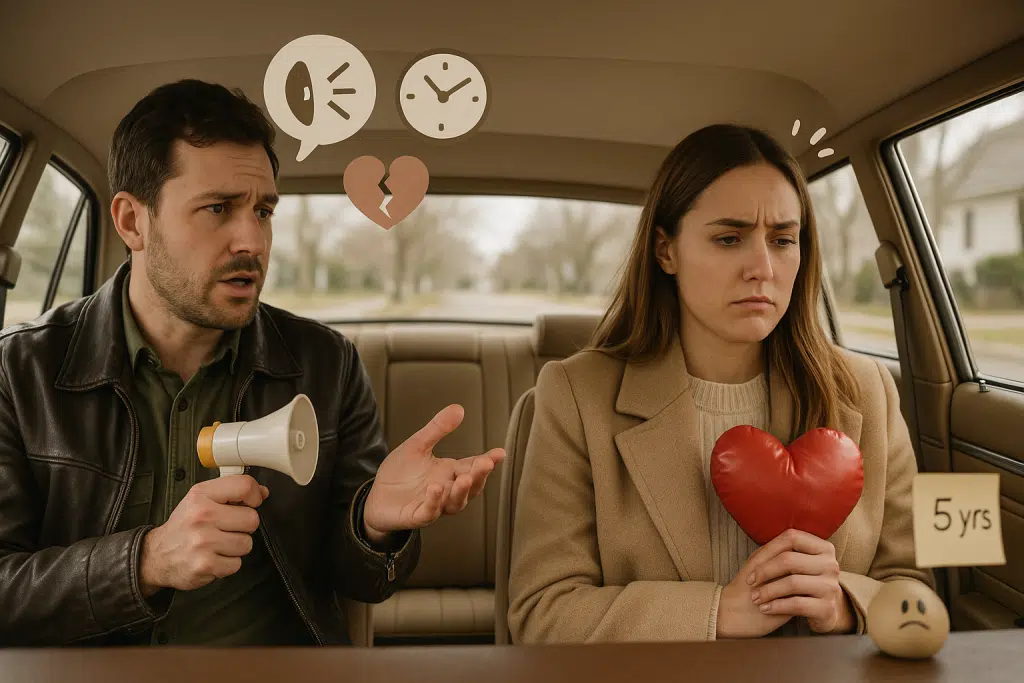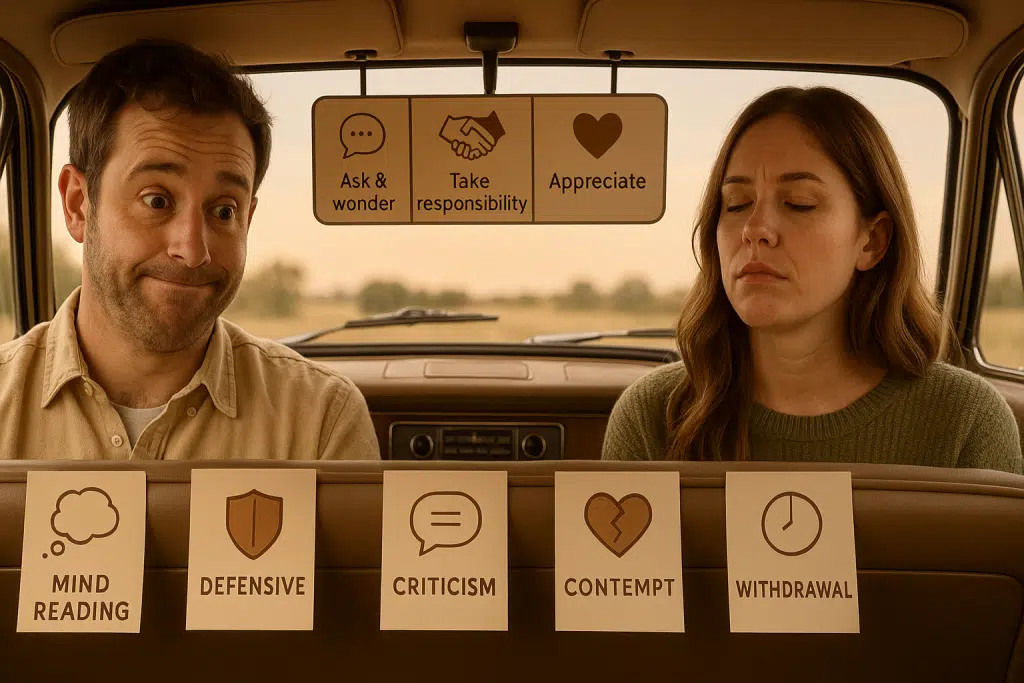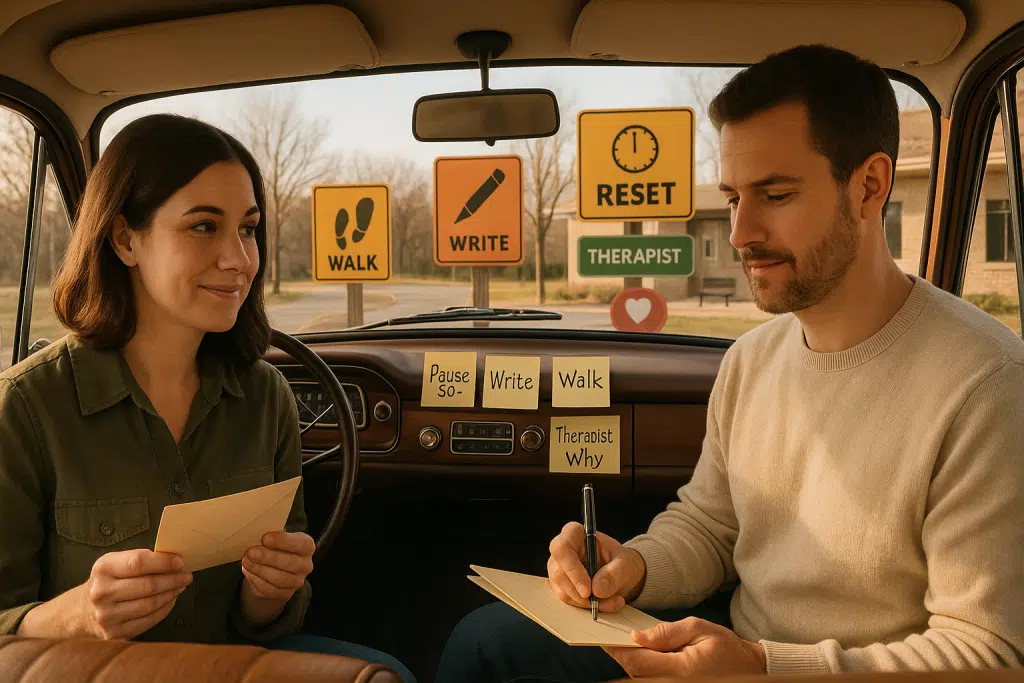Have you ever felt that moment when words with your partner suddenly become a barrier instead of a bridge? When what begins as a simple conversation transforms into disconnection, leaving you both feeling misunderstood and alone? These communication breakdowns touch the core of what makes relationships both challenging and beautiful—our fundamental need to be understood by the person we love most.
At Couples Counselling Centre, we believe these difficult moments aren’t signs of a failing relationship but opportunities for deeper connection. With compassionate awareness and practical skills, the very conversations that once drove you apart can become the foundation for a more secure bond.
Understanding Why We Disconnect Through Words

Before exploring solutions, let’s honour the complexity of what happens when communication breaks down between two people who care deeply for one another.
Three Common Roots of Communication Struggles
Different communication approaches: Some of us speak directly, while others communicate through subtlety. Some process thoughts verbally in real-time; others need quiet reflection before sharing. Research shows that up to 70% of couples navigate these fundamental differences in how they communicate.
Emotional vulnerability: Each of us carries invisible emotional histories that can be activated in conversation. These tender places—what therapists call “triggers”—can instantly transform dialogue into disconnection when touched unintentionally.
Contextual challenges: Attempting meaningful conversation when either partner is depleted, stressed, or distracted creates a foundation that rarely supports understanding.
What’s particularly meaningful to recognize is that many couples revisit the same communication challenges for 5-7 years before seeking support—not because they lack commitment, but because these patterns can be difficult to recognize from within the relationship itself.
Five Pathways to Restored Communication

Let’s explore practical approaches that honour both the science of effective communication and the unique dynamics of your relationship.
1. The Compassionate Pause Practice
When conversations begin to feel unsafe or unproductive, a structured pause can create space for reconnection.
How to practice this together:
- Create a shared, neutral phrase that either partner can use to pause (“I’d like to take a breather”)
- When expressed, both partners commit to a 20-minute reset
- Return to the conversation with renewed presence and a softer approach
Example: “I notice I’m not able to listen well right now. I’d like to take a breather so I can be more present when we continue. Can we pause for 20 minutes and try again?”
2. The Experience-Expression Approach
This practice helps separate what happened from how it affected you emotionally—a crucial distinction for healing conversations.
- Describe the situation without judgment or interpretation
- Share your emotional experience with ownership
- Express needs with an invitation for collaboration
Before: “You always ignore me for your phone when I’m talking to you!”
After: “When our conversation paused while you checked your phone (situation), I felt a wave of sadness and disconnection (emotional experience). I really value feeling fully present with each other. Could we talk about how we might protect our conversation time? (collaborative invitation)”
3. The Curiosity Bridge
When interpretation gaps arise, this three-step approach creates understanding where assumptions once stood.
- Acknowledge what you observed
- Share how you might interpret it while remaining open
- Invite your partner’s reality with genuine curiosity
Example: “When you became quiet during our discussion about holiday plans (observation), I wondered if you might be feeling overlooked or perhaps just needing time to think (possible interpretations). I’d really like to understand what was happening for you in that moment (curious invitation).”
4. The Connection Foundation
Dr. John Gottman’s research reveals something profound: relationships thrive when positive interactions outnumber challenging ones by at least five to one. This isn’t about avoiding difficult conversations but creating a secure foundation from which to have them.
Daily connection practices:
- Share one specific appreciation about your partner’s character
- Express physical affection that feels nurturing to both of you
- Ask one question born from genuine curiosity about their experience
- Celebrate one moment of joy or success, however small
- Respond with presence when your partner reaches toward you emotionally
This foundation of positive connection becomes the emotional safety net that catches you both during inevitable communication challenges.
5. The Present-Moment Expression
Our nervous systems can only remain receptively engaged for limited periods during challenging conversations. This technique honours that physiological reality.
The practice:
- Express your experience concisely (about 2 minutes)
- Use language that owns your perspective
- Conclude with an invitation that welcomes partnership
Example: “I’ve been feeling a sense of distance between us lately. I miss the feeling of being emotionally close and sharing the small moments of our days. I find myself feeling alone even when we’re in the same room. I wonder if we might explore together what might help us feel more connected again?”
Communication Patterns That Create Distance (And How to Transform Them)

Certain communication habits can silently erode intimacy over time. Here’s how to recognize and transform them:
| Pattern | How It Appears | Healing Alternative |
| Mind Reading | “I know you think I’m being too sensitive.” | “I’m wondering what you’re thinking about this situation.” |
| Defensive Responses | “That’s not fair—you do the same thing!” | “I can see how that impacted you. My experience was…” |
| Personal Criticism | “You never think about my feelings.” | “I felt hurt when my feelings weren’t acknowledged.” |
| Contemptuous Communication | Eye-rolling, sarcasm, dismissive tone | Expressing authentic feelings directly with respect |
| Emotional Withdrawal | Shutting down, refusing to engage | “I’m feeling overwhelmed right now. Can we revisit this in an hour when I can be more present?” |
The Four Communication Patterns That Predict Relationship Distress
Research has identified four communication patterns that can seriously undermine relationship health when they become habitual: criticism, contempt, defensiveness, and stonewalling. Here’s how to transform each one:
Criticism → Gentle Startup: Replace blame with “I” statements that express your feelings and needs Contempt → Culture of Appreciation: Cultivate regular expressions of respect and gratitude Defensiveness → Responsibility: Listen for the truth in your partner’s perspective before responding Stonewalling → Self-Regulation: Learn to recognize when you’re emotionally flooded and take care of yourself
Technology and Relationship Communication: Finding Balance

The digital world offers both opportunities and challenges for couple communication.
When Technology Supports Connection:
- Sending thoughtful messages of appreciation during busy days
- Using calendar functions to protect quality time together
- Sharing meaningful content that helps you understand each other better
When Technology Creates Distance:
- Dividing attention between screens and conversation
- Using text for emotionally complex discussions
- Avoiding difficult conversations by retreating into devices
A thought worth considering: “The greatest gift you can give another person is your presence.” – Thich Nhat Hanh
Honouring Different Communication Styles
Your communication differences aren’t flaws to fix but opportunities to grow together with greater understanding.
Direct and Contextual Communicators
Direct communicators value:
- Clarity and efficiency
- Getting to the heart of the matter
- Explicit expression of thoughts
Contextual communicators value:
- Relational harmony
- Background understanding
- Preserving emotional safety
Bridge-building approach: Direct communicators can add relational context (“This is important to me because I care about us”), while contextual communicators can practice naming needs directly (“What would help me feel secure is…”).
Emotional and Analytical Processors
Emotional processors need:
- Space to express feelings to make sense of them
- Validation before problem-solving
- Emotional resonance and mirroring
Analytical processors need:
- Time to process internally
- Structure and clear outcomes
- Information to integrate
Bridge-building approach: Create conversation agreements that honour both needs: “Let’s make space for feelings first, then move to solutions after we both feel heard.”
When Your Communication Needs Additional Support

When communication patterns have become particularly entrenched, professional guidance can offer a path forward:
- Take a meaningful pause: Give yourselves permission for a true reset (30+ minutes) when conversations become unproductive.
- Consider written expression: Sometimes writing allows for reflection that speaking doesn’t permit.
- Change your environment: Physical space affects emotional space—a walk together can shift perspective.
- Welcome professional support: A skilled couples therapist provides both safety and structure when you can’t create it yourselves.
- Reconnect with your deeper “why”: Keep visible reminders of what this relationship means to you beyond current challenges.
When Professional Support Makes Sense
While many communication challenges can be addressed within the relationship, some situations particularly benefit from professional guidance:
- When the same conversation repeats without resolution
- When one or both partners have emotionally withdrawn
- When trust has been significantly compromised
- When communication triggers trauma responses
- When you sense there are deeper patterns at play
Seeking professional support isn’t an admission of failure but an act of profound commitment to your relationship’s health and growth. Just as we consult experts in other important areas of life, relationships sometimes need specialized care.
The Heart of Communication Healing

Here’s what we know to be true after years of supporting couples through communication challenges: effective communication isn’t an innate talent—it’s a skill developed through intention, practice, and mutual commitment to growth.
The couples who thrive aren’t those who never struggle to communicate, but those who learn to repair disconnection with growing skill and tenderness. Each repair strengthens the foundation of your relationship, creating greater security and resilience.
Remember that perfect communication isn’t the goal—connection is. And connection happens not just through words but through the courage to remain present, the willingness to be vulnerable, and the commitment to understanding each other’s worlds.
We honour the courage it takes to look at communication patterns honestly and the strength required to begin changing them. In this sacred work of growing together, may you discover that the very conversations that once created distance can become your pathway to the secure, loving connection you both deserve.












